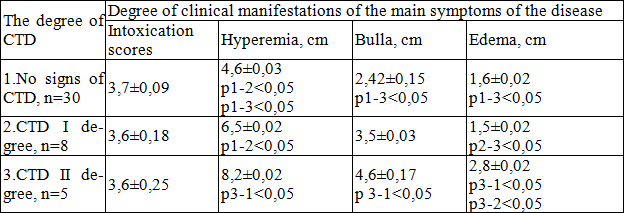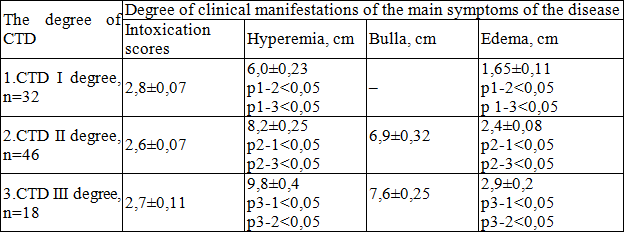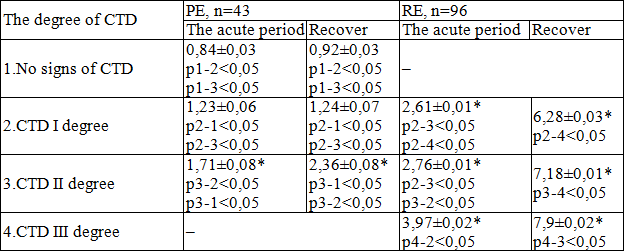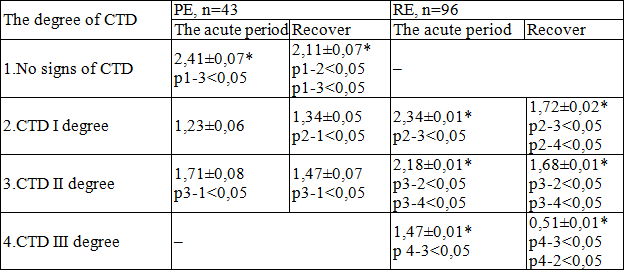Introduction. Today erysipelas is regarded as a disease caused by beta-hemolytic streptococcus group A and is characterized by focal serous or serous-hemorrhagic inflammation of the skin, mucous membranes, accompanied by fever and general toxic manifestations [1, 2]. Not having the propensity to epidemic spread, erysipelas, however, presents a serious problem for practical public health since this disease is characterized by tendency to grow with extremely high rates, as in all Russia and especially in Ivanovo region [3-5]. Connective tissue, being ubiquitous in the body involved in all processes, possibly, changes in the morph functional structure of the connective tissue leading factor for the development of recurrent erysipelas [6]. There is a group of genetically determined disorders of connective tissue, characterized by defects in its fibrous structures and the basic substance. This anomaly of connective tissue termed by "dysplasia" [7]. Most researchers believe that the connective tissue dysplasia (CTD) leads to disruption of homeostasis in tissue, organ, and organism levels and is manifested in a variety of morphological and functional disturbances of visceral and loco motor organs, which determines the characteristics associated pathology [8]. Quantitative and qualitative disorders of the biosynthesis and degradation of collagen determine the spectrum of clinical symptoms, which in English speaking countries refer to as the "hereditary collagen diseases" (Hereditary Disorders of Collagen) or collagen genetic disease "(Genetic Disorders of Collagen) [9]. The aim of the study was to examine the prevalence of CTD in patients with erysipelas and to examine the affection of connective tissue dysplasia on the clinical manifestations and number of erysipelas relapse.
Materials and methods. The study was done on 139 hospitalized patients aged 21 to 60 years, in the infectious department № 2 City Clinical Hospital № 1, Ivanovo (Russia). 43 (30,9%) patients had primary erysipelas. Recurrent erysipelas was present in 96 (69,1%) patients. Diagnosis of CTD was based on the identification the dysplastic features of the connective tissue, measurable clinical assessment and fixing dysembryogenetic stigma. In order to conduct a retrospective analysis of the patients, patients medical files has been studied. Assessment of the severity of intoxication syndrome in the acute period scaled by points. Course of the disease on a background of normal body temperature corresponded to a score of 0, increased body temperature from 37°C to 37,9°C was estimated to be 1 point, increase in temperature from 38°C to 38,9°C – 2 points, an increase in body temperature from 39°C to 40°C – 3 points. When patient register with one of the following symptoms – weakness, headache, nausea, vomiting – 1 extra point added. Hyperemia of the skin and bulla diameter was estimated in centimeters. Edema measurement of extremities in patients with erysipelas done by measuring its circumference (in centimeters) compared with the healthy extremity. To assess the severity of intoxication and the degree of sensitization computational integral indicators found - leukocyte intoxication index (LII) and the index allergization (IA), which are based on a certain ratio of blood cells [10]. Normal value of IA is 0,68-1,08 standard unit. Normal value of LII is 0,3-1,5 standard unit.
Results and discussion. Among the observed patients with recurrent erysipelas (RE) the following results are found: mild (I degree) CTD found in 32 patients (33,3%), moderate (II degree) in 46 patients (47.9%), severe in 18 (18,8% ). In patients with primary erysipelas (PE) mild CTD is defined in 8 patients (18,6%), moderate in 5 (11,6%). Severe forms of CTD negative, there were no signs of CTD in 30 patients (69,8%). It is known that the presence of CTD adversely affect the course of the underlying disease. We have examined the influence of the severity of connective tissue dysplasia on the nature of the course and the main clinical manifestations of erysipelas (tables 1, 2). It was found that the severity of intoxication syndrome in primary and recurrent erysipelas in patients with varying degrees of CTD did not differ significantly. In patients with primary and recurrent erysipelas in the acute period there was a significant (p<0.05) increase in hyperemia, bulla and edema with respect to CTD degree. Bulla were only in patients with severe CTD. According to our study, patients with recurrent erysipelas correlated with the degree of connective tissue dysplasia. Over a period of 2-years follow-up of patients relapsing erysipelas often observed it in patients with III degree CTD – the frequency of recurrence was 8,7±0,44 times. When the II degree of CTD, it was 5,8±0,27 times, when I degree – 3,4±0,14 times.
Table 1. The degree of severity of clinical manifestations of the main symptoms of primary erysipelas in the acute period, depending on degree of connective tissue dysplasia.

Table 2. The degree of severity of clinical manifestations of the main symptoms of recurrent erysipelas in the acute period, depending on degree of connective tissue dysplasia.

Among the factors contributing to the formation of recurrent erysipelas, the existence of isolated pockets of chronic bacterial infection and increased sensitization. We analyzed the hematological changes in patients with primary and recurrent erysipelas. In patients with PE with no signs of CTD, the rate of IA in the acute period was within the normal range and was lower than in patients with CTD I and II degree. IA in patients with CTD II degree in the acute period was significant higher than in patients with CTD I degree (table 3).
Table 3. Index allergization in different periods of the pathological process.

* Significance in different periods of the erysipelas p<0,05.
In patients with RE in acute period a similar trend: IA in patients with CTD I grade was lower than in patients with CTD II and III degree. In the recovery period in patients with PE and without signs of CTD, IA remained within the normal range. Patients with CTD III degrees and patient with RE recorded significant increase of IA. In patients with primary erysipelas without signs of CTD in the acute phase of leukocyte intoxication index (LII), which characterizes the degree of endogenous intoxication and calculated by the formula Kalf-Khalif, greatly exceeded the normal standards and was 2,41±0,07 standard unit (table 4).
Table 4. Leukocyte index of intoxication in different periods of the pathological process.

* Significance in different periods of the erysipelas p<0,05.
In the recovery period this index in patients was not normalized. In patients with CTD I or II level, leukocyte index of intoxication in the acute period was lower, during the recovery period this index was normalized. of a pathological condition. In patients with RE, with CTD I and II degree in acute period the index of intoxication was higher than normal, and during the recovery period LII in these patients significantly decreased, but did not reach the norm (1,72±0,02 standard unit - in patients with CTD I degree, 1,68±0,01 standard unit - in patients with CTD II degree). In patients with recurrent course of erysipelas and CTD III LII degree in both periods of the disease was in normal range. Weakness of connective tissue structures in the dermis provides more pronounced skin lesions, contributes to the severity of the disease by the addition of bulls, increasing expression of the local manifestations of erysipelas (edema, hyperemia) and more likely erysipelas appear in the next 2 years. Thus, the presence of CTD syndrome has a significant influence on the course of local symptoms in patients with erysipelas. Moreover, their expression is determined by the degree of connective tissue dysplasia. Among patients we observed the highest value of index intoxication in acute period were patients with primary erysipelas without signs of connective tissue dysplasia, and with recovery erysipelas and CTD I. The LII index, which reflects the persistence of the pathogen in the body, remained elevated even in the recovery period. These data indicate slowing elimination of the pathogen from the body of patients with PE not having symptoms of CTD, and in patients with RE with CTD I degree. Thus, in these patients the most important the genesis of the disease is infectious component. The IA in acute period and during the recovery in patients with RE, CTD III degree was the highest. This demonstrates the increased sensitization of the body, reflected in an increase rate of IA, which is conserved in recovery RE, as well as in patients with PE CTD II degree.
Conclusion. Our study showed that the majority (78,4%) of patients with erysipelas are characterized by presence of CTD. It influences on clinical manifestations of erysipelas, by raising the local symptoms and number of relapses. In patients with primary erysipelas without signs of connective tissue dysplasia and with recovery erysipelas and CTD I elimination of the pathogen from the organism does not occur, as indicated by the continuing high rate LII, and in the development erysipelas the main factor is infection, with slight involvement of allergy. In patients with RE and severe CTD the leading mechanism is the increased sensitization of the organism, which is stored in the recovery period and contributes to recurrence.